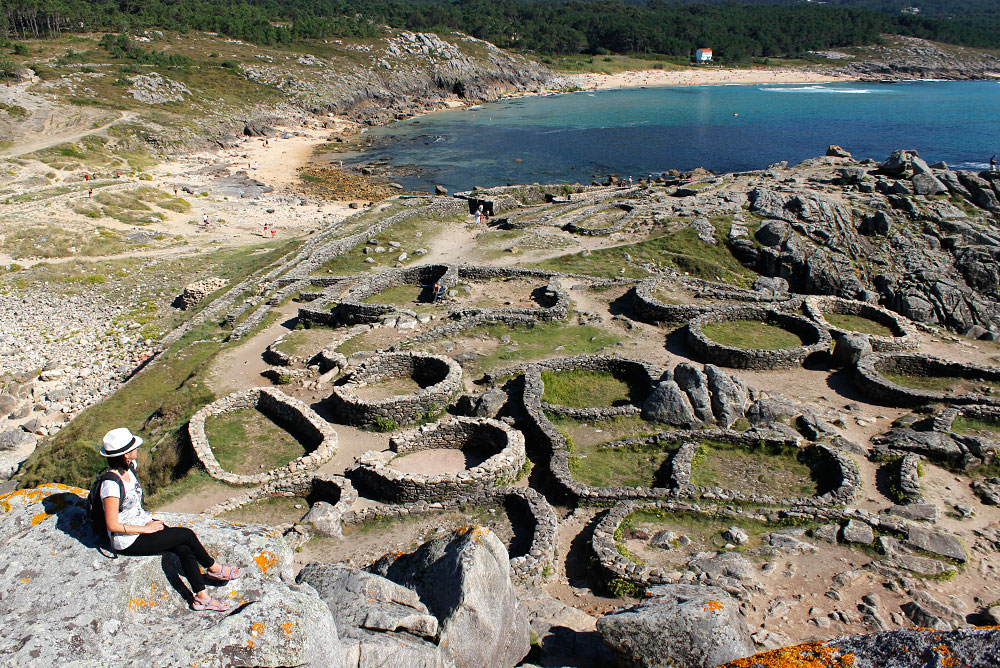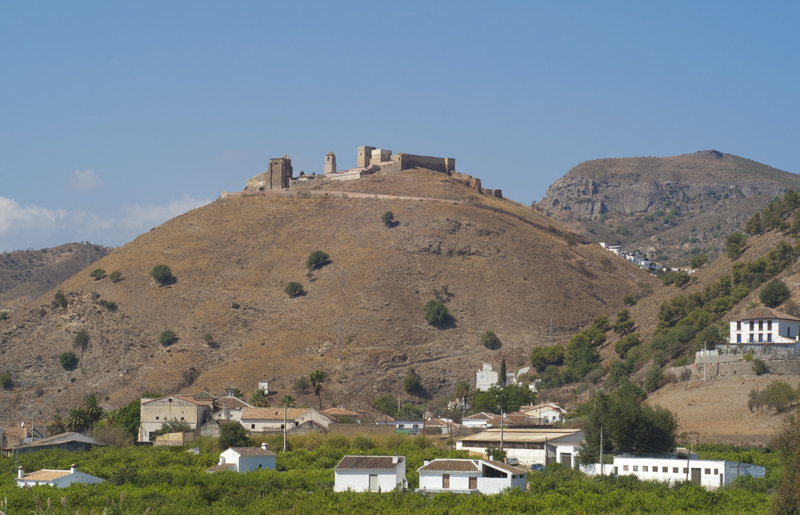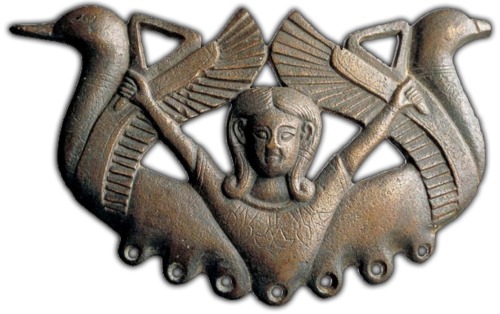Iron Age History
The Iron Age in the Iberian peninsula has two focuses: the Hallstatt-related Iron Age Urnfields of the North-East and the Phoenician colonies of the South.
During the Iron Age, considered the protohistory of the territory, the Celts came, in several waves, starting possibly before 600 BC.
The Southwest Paleohispanic script, also called Tartessian, present in the Algarve and Lower Alentejo from about the late 8th to the 5th century BC, is possible the oldest script in Western Europe and it could have come from the Eastern Mediterranean, perhaps from Anatolia or Greece.
Early iron age cultures
 Since the late 8th century BC, the Urnfield culture of North-East Iberia began to develop Iron metallurgy and, eventually, elements of the Hallstatt culture. The earliest elements of this culture were found along the lower Ebro river, then gradually expanded upstream to La Rioja and in a hybrid local form to Alava. There was also expansion southwards into Castelló, with less marked influences reaching further south. Additionally, some offshoots have been detected along the Iberian Mountains, possibly a prelude to the formation of the Celtiberi.
Since the late 8th century BC, the Urnfield culture of North-East Iberia began to develop Iron metallurgy and, eventually, elements of the Hallstatt culture. The earliest elements of this culture were found along the lower Ebro river, then gradually expanded upstream to La Rioja and in a hybrid local form to Alava. There was also expansion southwards into Castelló, with less marked influences reaching further south. Additionally, some offshoots have been detected along the Iberian Mountains, possibly a prelude to the formation of the Celtiberi.
During this period, the social differentiation became more visible with evidence of local chiefdoms and a horse-riding elite. It is possible that these transformations represent the arrival of a new wave of cultures from central Europe.
From these outposts in the Upper Ebro and the Iberian mountains, Celtic culture expanded into the plateau and the Atlantic coast. Several groups can be described:
- The Bernorio-Miraveche group (northern Burgos and Palencia provinces), that would influence the peoples of the northern fringe.
- The north-west Castro culture, in today's Galicia and northern Portugal, a Celtic culture but with peculiarities due to the persistence of aspects of an earlier Atlantic Bronze Age culture.
- The Duero group, possibly the precursor of the Celtic Vaccei.
- The Cogotas II culture, likely precursor of the Celtic or Celtiberian Vettones (or a pre-Celtic culture with substantial Celtic influences), a markedly cattle-herder culture that gradually expanded southwards into what is today's Extremadura.
- The Lusitanian culture, the precursor of the Lusitani tribe, located in what is today's central Portugal and Extremadura in western Spain, is generally not considered Celtic since the Lusitanian language does not meet some the accepted definitions of a Celtic language. Its relationship with the surrounding Celtic culture is unclear. Some believe it was essentially a pre-Celtic Iberian culture with substantial Celtic influences, while others argue that it was an essentially Celtic culture with strong indigenous pre-Celtic influences. There have been arguments for classifying its language as either Italic, a form of archaic Celtic, or proto-Celtic.
All these Indo-European groups have some common elements, like combed pottery since the 6th century and uniform weaponry.
After c. 600 BC, the Urnfields of the North-East were replaced by the Iberian culture, in a process that wasn't completed until the 4th century BC. This physical separation from their continental relatives would mean that the Celts of the Iberian peninsula never received the cultural influences of La Tène culture, including Druidism.
Phoenician colonies and influence
The Phoenicians of Asia, Greeks of Europe, and Carthaginians of Africa all colonized parts of Iberia to facilitate trade. During the 10th century BC, the first contacts between Phoenicians and Iberia (along the Mediterranean coast) were made. This century also saw the emergence of towns and cities in the southern littoral areas of eastern Iberia.
The Phoenicians founded colony of Gadir (modern Cádiz) near Tartessos. The foundation of Cádiz, the oldest continuously-inhabited city in western Europe, is traditionally dated to 1104 BC, although, as of 2004, no archaeological discoveries date back further than the 9th century BC. The Phoenicians continued to use Cádiz as a trading post for several centuries leaving a variety of artifacts, most notably a pair of sarcophaguses from around the 4th or 3rd century BC. Contrary to myth, there is no record of Phoenician colonies west of the Algarve (namely Tavira), even though there might have been some voyages of discovery. Phoenician influence in what is now Portuguese territory was essentially through cultural and commercial exchange with Tartessos.
 During the 9th century BC, the Phoenicians, from the city-state of Tyre founded the colony of Malaka (modern Málaga) and Carthage (in North Africa). During this century, Phoenicians also had great influence on Iberia with the introduction the use of Iron, of the Potter's wheel, the production of Olive oil and Wine. They were also responsible for the first forms of Iberian writing, had great religious influence and accelerated urban development. However, there is little evidence to support the myth of a Phoenician foundation of the city of Lisbon as far back as 1300 BC, under the name Alis Ubbo ("Safe Harbour"), even if in this period there are organized settlements in Olissipona (modern Lisbon, in Portuguese Estremadura) with clear Mediterranean influences.
During the 9th century BC, the Phoenicians, from the city-state of Tyre founded the colony of Malaka (modern Málaga) and Carthage (in North Africa). During this century, Phoenicians also had great influence on Iberia with the introduction the use of Iron, of the Potter's wheel, the production of Olive oil and Wine. They were also responsible for the first forms of Iberian writing, had great religious influence and accelerated urban development. However, there is little evidence to support the myth of a Phoenician foundation of the city of Lisbon as far back as 1300 BC, under the name Alis Ubbo ("Safe Harbour"), even if in this period there are organized settlements in Olissipona (modern Lisbon, in Portuguese Estremadura) with clear Mediterranean influences.
There was strong Phoenician influence and settlement in the city of Balsa (modern Tavira in the Algarve) in the 8th century BC. Phoenician influenced Tavira was destroyed by violence in the 6th century BC. With the decadence of Phoenician colonization of the Mediterranean coast of Iberia in the 6th century BC many of the colonies are deserted. The 6th century BC also saw the rise of the colonial might of Carthage, which slowly replaced the Phoenicians in their former areas of dominion.
Greek colonies
The Greek colony at what now is Marseilles began trading with the Iberians on the eastern coast around the 8th century BC. The Greeks finally founded their own colony at Ampurias, in the eastern Mediterranean shore (modern Catalonia), during the 6th century BC beginning their settlement in the Iberian peninsula. There are no Greek colonies west of the Strait of Gibraltar, only voyages of discovery. There is no evidence to support the myth of an ancient Greek founding of Olissipo (modern Lisbon) by Odysseus.
The Tartessian culture
The name Tartessian, when applied in archaeology and linguistics does not necessarily correlate with the semi-mythical city of Tartessos but only roughly with the area where it is typically assumed it should have been located.
 The Tartessian culture of southern Iberia actually is the local culture as modified by the increasing influence of eastern Mediterranean elements, especially Phoenician. Its core area is Western Andalusia, but soon extends to Eastern Andalusia, Extremadura and the Lands of Murcia and Valencia, where a Tartessian complex, rooted in the local Bronze cultures, is in the last stages of the Bronze Age (ninth-eighth centuries BC) before Phoenician influences can be seen clearly.
The Tartessian culture of southern Iberia actually is the local culture as modified by the increasing influence of eastern Mediterranean elements, especially Phoenician. Its core area is Western Andalusia, but soon extends to Eastern Andalusia, Extremadura and the Lands of Murcia and Valencia, where a Tartessian complex, rooted in the local Bronze cultures, is in the last stages of the Bronze Age (ninth-eighth centuries BC) before Phoenician influences can be seen clearly.
The full Tartessian culture, beginning c.720 BC, also extends to southern Portugal, where is eventually replaced by Lusitanian culture. One of the most significant elements of this culture is the introduction of the potter's wheel, that, along with other related technical developments, causes a major improvement in the quality of the pottery produced. There are other major advances in craftsmanship, affecting jewelry, weaving and architecture. This latter aspects is especially important, as the traditional circular huts were then gradually replaced by well finished rectangular buildings. It also allowed for the construction of the tower-like burial monuments that are so typical of this culture.
Agriculture also seems to have experienced major advances with the introduction of steel tools and, presumably, of the yoke and animal traction for the plough. In this period it's noticeable the increase of cattle accompanied by some decrease of sheep and goat types.
Another noticeable element is the major increase in economical specialization and social stratification. This is very noticeable in burials, with some showing off great wealth (chariots, gold, ivory), while the vast majority are much more modest. There is much diversity in burial rituals in this period but the elites seem to converge in one single style: a chambered mound. Some of the most affluent burials are generally attributed to local monarchs.
One of the developments of this period is writing, a skill which was probably acquired through contact with the Phoenicians. John T. Koch controversially claimed to have deciphered the extant Tartessian inscriptions and to have tentatively identified the language as an earlier form of the Celtic languages now spoken in the British Isles and Brittany in the book 'Celtic from the West', published in 2010. However, the linguistic mainstream continues to treat Tartessian as an unclassified, possibly pre-Indo-European language, and Koch's decipherment of the Tartessian script and his theory for the evolution of Celtic has been strongly criticized.
The Iberian culture
In the Iberian culture people were organized in chiefdoms and states. Three phases can be identified: the Ancient, the Middle and the Late Iberian period.
With the arrival of Greek influences, not limited to their few colonies, the Tartessian culture begins to transform itself, especially in the South East. This late period is known as the Iberian culture, that in Western Andalusia and the non-Celtic areas of Extremadura is called Ibero-Turdetanian because of its stronger links with the Tartessian substrate.
The Hellenic influence is visible in the gradual change of the style of their monuments that approach more and more the models arrived from the Greek world. Thus the obelisk-like funerary monuments of the previous period now adopt a column like form, totally in line with Greek architecture.
By the middle of the 5th century, aristocratic power was increased and resulted in the abandonment and transformation of the orientalizing model. The oppidum appeared and became the socio-economic model of the aristocratic class. The commerce was also one of the principal sources of aristocratic control and power. In the south east, between the end of the 5th and the end of the 4th century BC, appeared a highly hierarchical aristocratic society. There were different forms of political control. The power and control seemed to be in the hand of kings or reguli.
Iberian funerary customs are dominated by cremation necropolis, that are partly due to the persistent influences of Urnfield culture, but they also include burial customs imported from the Greek cultural area (mudbrick rectangular mound).
Urbanism was important in the Iberian cultural area, especially in the south, where Roman accounts mention hundreds of oppida (fortified towns). In these towns (some quite large, some mere fortified villages) the houses were typically arranged in contiguous blocks, in what seems to be another Urnfield cultural influx.
The Iberian script evolved from the Tartessian one with Greek influences that are noticeable in the transformation of some characters. In a few cases a variant of Greek alphabet (Ibero-Ionian script) was used to write Iberian as well.
The transformation from Tartessian to Iberian culture was not sudden but gradual and was more marked in the East, where it begins in the 6th century BC, than in the south-west, where it is only noticeable since the 5th century BC and much more tenuous. A special case is the north-east where the Urnfield culture was Iberized but keeping some elements from the Indo-European substrate.
Post-Tartessos Iron Age
Also during the 6th century BC there was a cultural shift in south-western Iberia (what is now southern Portugal and the nearby areas of Andalusia) after the fall of Tartessos, with a strong Mediterranean character that prolonged and modified Tartessian culture. This occurred mainly in Low Alentejo and the Algarve, but had littoral extensions up to the Sado mouth (namely the important city of Bevipo, modern Alcácer do Sal). The first form of writing in western Iberia (south of Portugal), the Southwest Paleohispanic script (still to be translated), dated to the 6th century BC, denotes strong Tartessian influence in its use of a modified Phoenician alphabet. In these writings the word "Conii" (similar to Cunetes or Cynetes, the people of the Algarve) appears frequently.
In the 4th century BC, the Celtici appear, a late expansion of Celtic culture into the south west (southern Extremadura, the Alentejo and northern Algarve areas). The Turduli and Turdetani, probably descendants of the Tartessians, although celticized, became established in the area of the Guadiana river, in the south of modern Portugal. A series of cities in the Algarve, such as Balsa (Tavira), Baesuris (Castro Marim), Ossonoba (Faro) and Cilpes (Silves), became inhabited by the Cynetes.
Arrival of Romans and Punic Wars
During the 4th century BC, Rome began to rise as a Mediterranean power rival to the north African based Carthage. After suffering defeat to the Romans in the First Punic War (264-241 BC), the Carthaginians began to extend their power into the interior of Iberia from their south eastern coastal settlements but this empire was to be short lived. In the Second Punic War (218-202 BC), the Carthaginian general Hannibal marched his armies, which included Iberians, from Iberia, across the Pyrenees and the Alps and attacked the Romans in Italy. Despite many victories, he was finally defeated and the Romans took revenge by destroying Carthage. Starting in the north-east, Rome began its conquest of the Iberian Peninsula.

